Economics for Business: An Analysis of Unemployment in Australia
VerifiedAdded on 2020/02/24
|17
|3629
|40
Report
AI Summary
This report provides a detailed analysis of unemployment in Australia, a crucial topic in economics. It begins with an introduction to unemployment, highlighting its significance and impact on the Australian economy, particularly among the youth. The report defines unemployment and discusses various types, including frictional, structural, cyclical, and seasonal unemployment. It explores the reasons behind rising unemployment rates in Australia, such as changing technology, outsourcing, recession, changes in the global market, industry shutdowns, immigration, off-shoring, and natural disasters. The report presents statistical data, including employment and unemployment growth over the past five years, unemployment rates, and youth unemployment figures, supported by tables and charts from reliable sources. Furthermore, the report examines actions taken by the Australian government to overcome unemployment. The conclusion summarizes the key findings and emphasizes the importance of addressing unemployment for economic stability and growth. References are provided to support the information presented in the report.
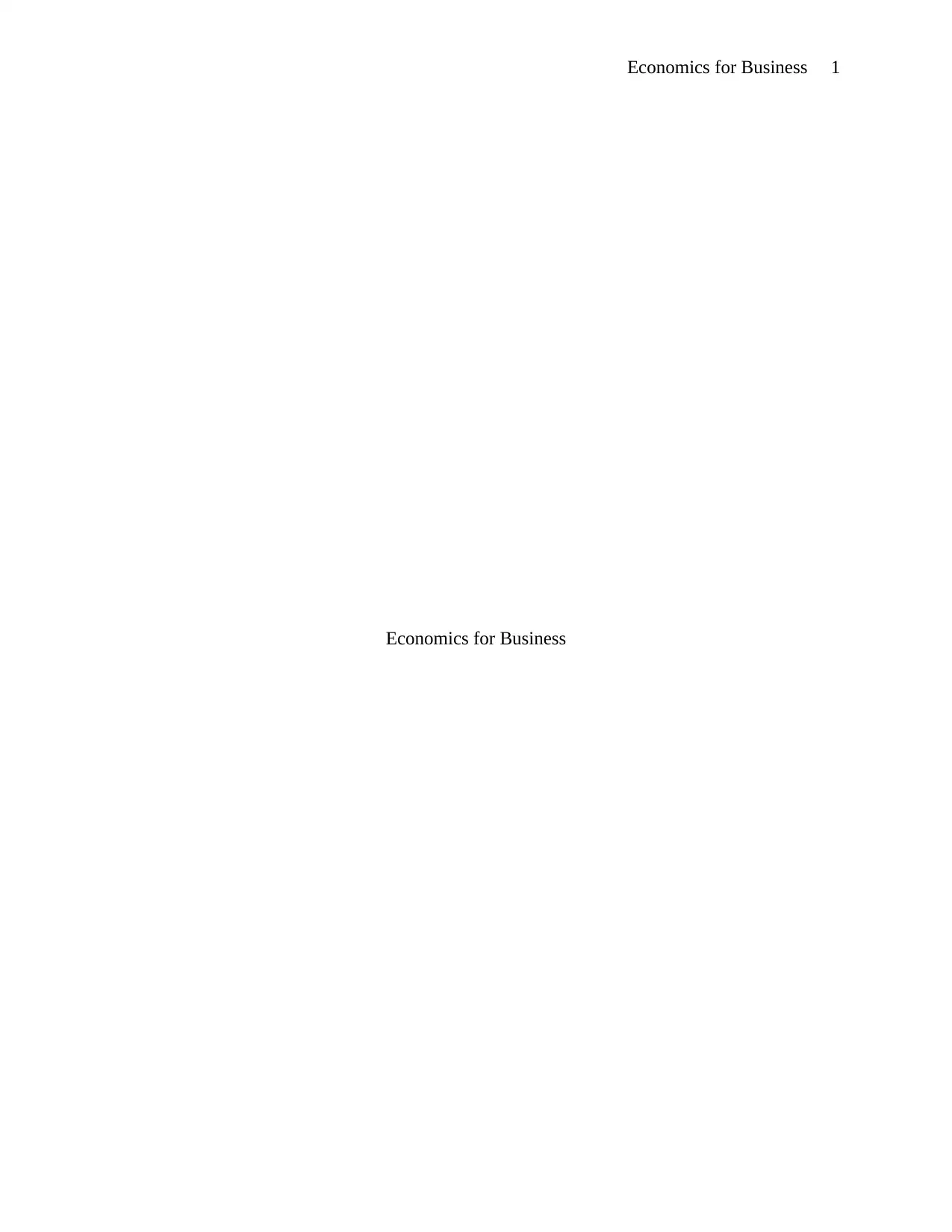
Economics for Business 1
Economics for Business
Economics for Business
Paraphrase This Document
Need a fresh take? Get an instant paraphrase of this document with our AI Paraphraser
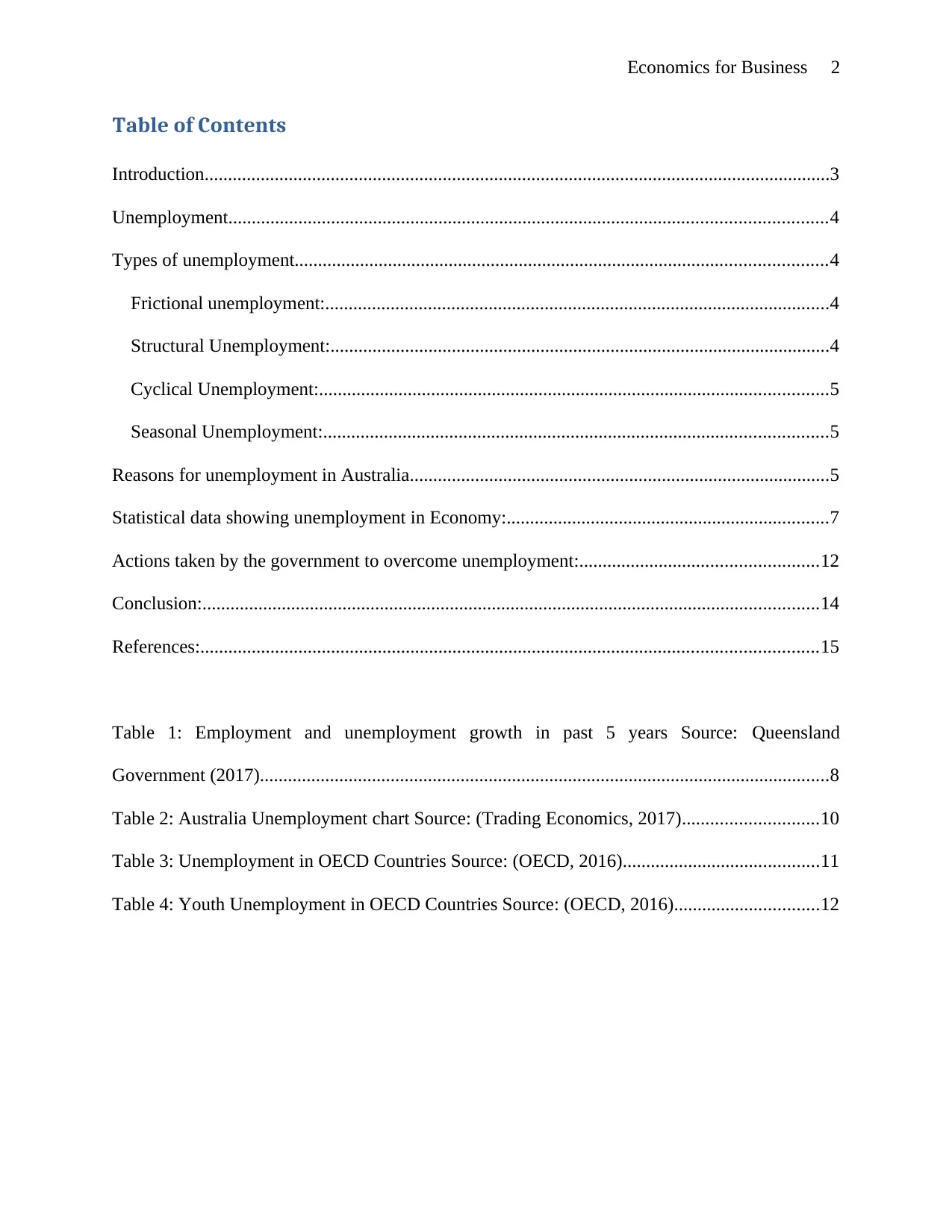
Economics for Business 2
Table of Contents
Introduction......................................................................................................................................3
Unemployment................................................................................................................................4
Types of unemployment..................................................................................................................4
Frictional unemployment:............................................................................................................4
Structural Unemployment:...........................................................................................................4
Cyclical Unemployment:.............................................................................................................5
Seasonal Unemployment:............................................................................................................5
Reasons for unemployment in Australia..........................................................................................5
Statistical data showing unemployment in Economy:.....................................................................7
Actions taken by the government to overcome unemployment:...................................................12
Conclusion:....................................................................................................................................14
References:....................................................................................................................................15
Table 1: Employment and unemployment growth in past 5 years Source: Queensland
Government (2017)..........................................................................................................................8
Table 2: Australia Unemployment chart Source: (Trading Economics, 2017).............................10
Table 3: Unemployment in OECD Countries Source: (OECD, 2016)..........................................11
Table 4: Youth Unemployment in OECD Countries Source: (OECD, 2016)...............................12
Table of Contents
Introduction......................................................................................................................................3
Unemployment................................................................................................................................4
Types of unemployment..................................................................................................................4
Frictional unemployment:............................................................................................................4
Structural Unemployment:...........................................................................................................4
Cyclical Unemployment:.............................................................................................................5
Seasonal Unemployment:............................................................................................................5
Reasons for unemployment in Australia..........................................................................................5
Statistical data showing unemployment in Economy:.....................................................................7
Actions taken by the government to overcome unemployment:...................................................12
Conclusion:....................................................................................................................................14
References:....................................................................................................................................15
Table 1: Employment and unemployment growth in past 5 years Source: Queensland
Government (2017)..........................................................................................................................8
Table 2: Australia Unemployment chart Source: (Trading Economics, 2017).............................10
Table 3: Unemployment in OECD Countries Source: (OECD, 2016)..........................................11
Table 4: Youth Unemployment in OECD Countries Source: (OECD, 2016)...............................12
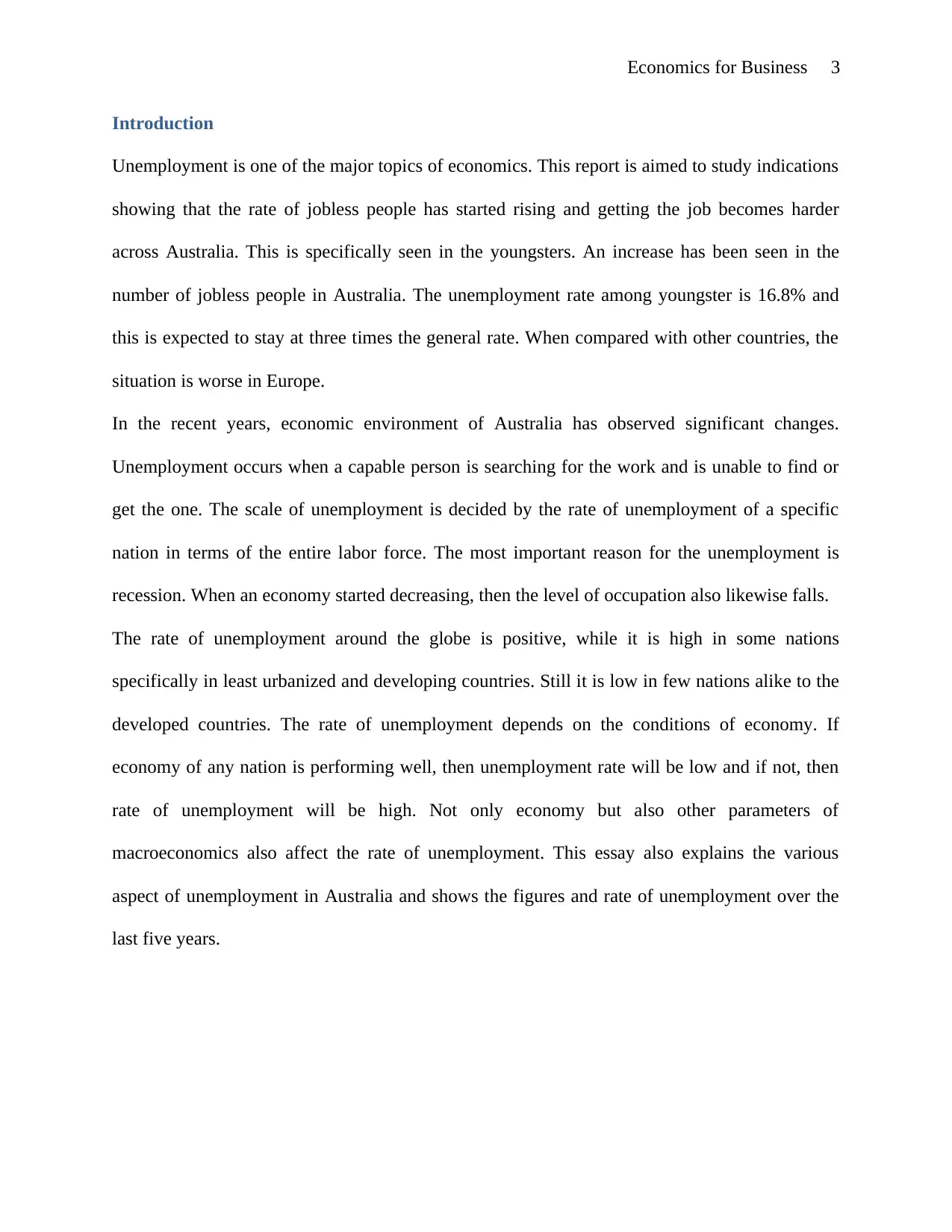
Economics for Business 3
Introduction
Unemployment is one of the major topics of economics. This report is aimed to study indications
showing that the rate of jobless people has started rising and getting the job becomes harder
across Australia. This is specifically seen in the youngsters. An increase has been seen in the
number of jobless people in Australia. The unemployment rate among youngster is 16.8% and
this is expected to stay at three times the general rate. When compared with other countries, the
situation is worse in Europe.
In the recent years, economic environment of Australia has observed significant changes.
Unemployment occurs when a capable person is searching for the work and is unable to find or
get the one. The scale of unemployment is decided by the rate of unemployment of a specific
nation in terms of the entire labor force. The most important reason for the unemployment is
recession. When an economy started decreasing, then the level of occupation also likewise falls.
The rate of unemployment around the globe is positive, while it is high in some nations
specifically in least urbanized and developing countries. Still it is low in few nations alike to the
developed countries. The rate of unemployment depends on the conditions of economy. If
economy of any nation is performing well, then unemployment rate will be low and if not, then
rate of unemployment will be high. Not only economy but also other parameters of
macroeconomics also affect the rate of unemployment. This essay also explains the various
aspect of unemployment in Australia and shows the figures and rate of unemployment over the
last five years.
Introduction
Unemployment is one of the major topics of economics. This report is aimed to study indications
showing that the rate of jobless people has started rising and getting the job becomes harder
across Australia. This is specifically seen in the youngsters. An increase has been seen in the
number of jobless people in Australia. The unemployment rate among youngster is 16.8% and
this is expected to stay at three times the general rate. When compared with other countries, the
situation is worse in Europe.
In the recent years, economic environment of Australia has observed significant changes.
Unemployment occurs when a capable person is searching for the work and is unable to find or
get the one. The scale of unemployment is decided by the rate of unemployment of a specific
nation in terms of the entire labor force. The most important reason for the unemployment is
recession. When an economy started decreasing, then the level of occupation also likewise falls.
The rate of unemployment around the globe is positive, while it is high in some nations
specifically in least urbanized and developing countries. Still it is low in few nations alike to the
developed countries. The rate of unemployment depends on the conditions of economy. If
economy of any nation is performing well, then unemployment rate will be low and if not, then
rate of unemployment will be high. Not only economy but also other parameters of
macroeconomics also affect the rate of unemployment. This essay also explains the various
aspect of unemployment in Australia and shows the figures and rate of unemployment over the
last five years.
⊘ This is a preview!⊘
Do you want full access?
Subscribe today to unlock all pages.

Trusted by 1+ million students worldwide
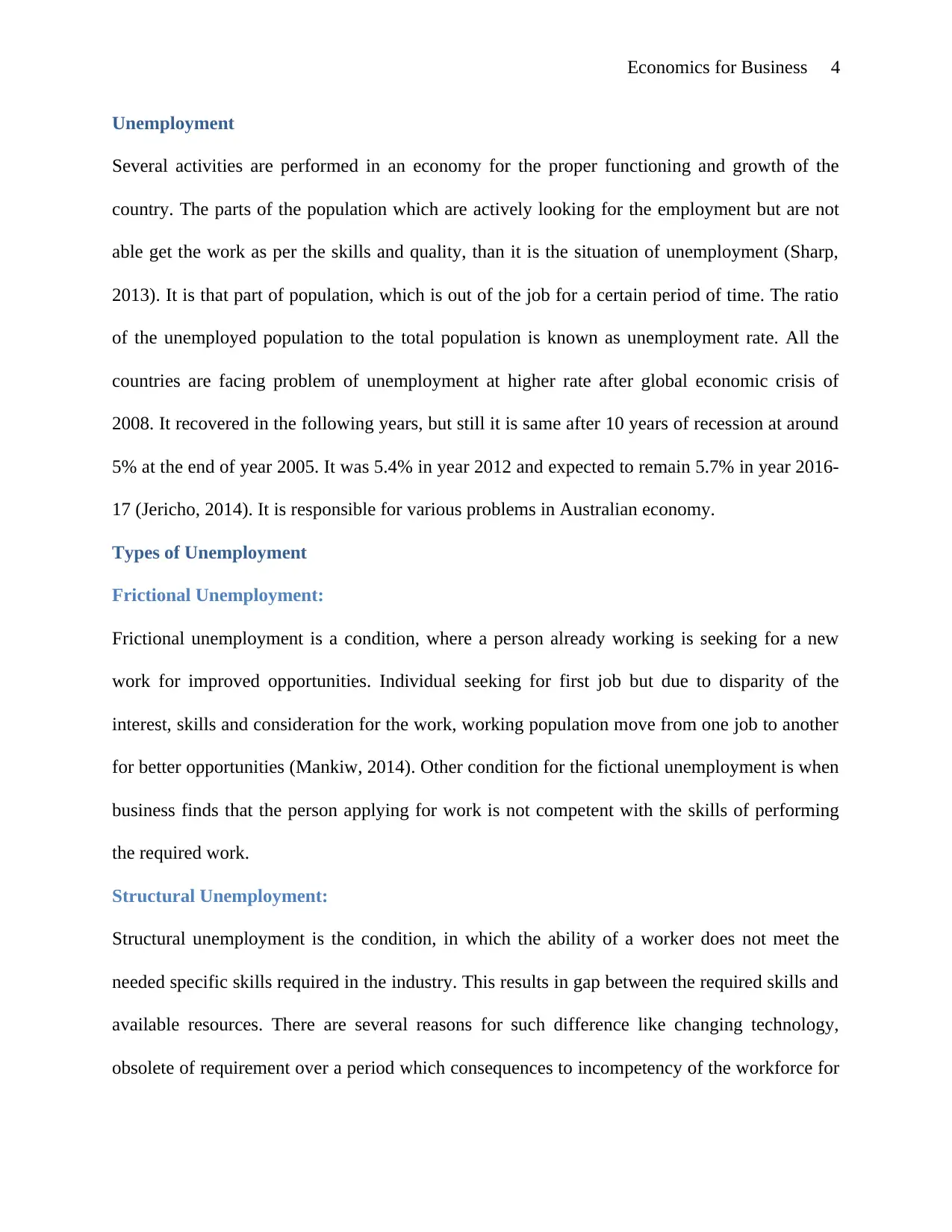
Economics for Business 4
Unemployment
Several activities are performed in an economy for the proper functioning and growth of the
country. The parts of the population which are actively looking for the employment but are not
able get the work as per the skills and quality, than it is the situation of unemployment (Sharp,
2013). It is that part of population, which is out of the job for a certain period of time. The ratio
of the unemployed population to the total population is known as unemployment rate. All the
countries are facing problem of unemployment at higher rate after global economic crisis of
2008. It recovered in the following years, but still it is same after 10 years of recession at around
5% at the end of year 2005. It was 5.4% in year 2012 and expected to remain 5.7% in year 2016-
17 (Jericho, 2014). It is responsible for various problems in Australian economy.
Types of Unemployment
Frictional Unemployment:
Frictional unemployment is a condition, where a person already working is seeking for a new
work for improved opportunities. Individual seeking for first job but due to disparity of the
interest, skills and consideration for the work, working population move from one job to another
for better opportunities (Mankiw, 2014). Other condition for the fictional unemployment is when
business finds that the person applying for work is not competent with the skills of performing
the required work.
Structural Unemployment:
Structural unemployment is the condition, in which the ability of a worker does not meet the
needed specific skills required in the industry. This results in gap between the required skills and
available resources. There are several reasons for such difference like changing technology,
obsolete of requirement over a period which consequences to incompetency of the workforce for
Unemployment
Several activities are performed in an economy for the proper functioning and growth of the
country. The parts of the population which are actively looking for the employment but are not
able get the work as per the skills and quality, than it is the situation of unemployment (Sharp,
2013). It is that part of population, which is out of the job for a certain period of time. The ratio
of the unemployed population to the total population is known as unemployment rate. All the
countries are facing problem of unemployment at higher rate after global economic crisis of
2008. It recovered in the following years, but still it is same after 10 years of recession at around
5% at the end of year 2005. It was 5.4% in year 2012 and expected to remain 5.7% in year 2016-
17 (Jericho, 2014). It is responsible for various problems in Australian economy.
Types of Unemployment
Frictional Unemployment:
Frictional unemployment is a condition, where a person already working is seeking for a new
work for improved opportunities. Individual seeking for first job but due to disparity of the
interest, skills and consideration for the work, working population move from one job to another
for better opportunities (Mankiw, 2014). Other condition for the fictional unemployment is when
business finds that the person applying for work is not competent with the skills of performing
the required work.
Structural Unemployment:
Structural unemployment is the condition, in which the ability of a worker does not meet the
needed specific skills required in the industry. This results in gap between the required skills and
available resources. There are several reasons for such difference like changing technology,
obsolete of requirement over a period which consequences to incompetency of the workforce for
Paraphrase This Document
Need a fresh take? Get an instant paraphrase of this document with our AI Paraphraser
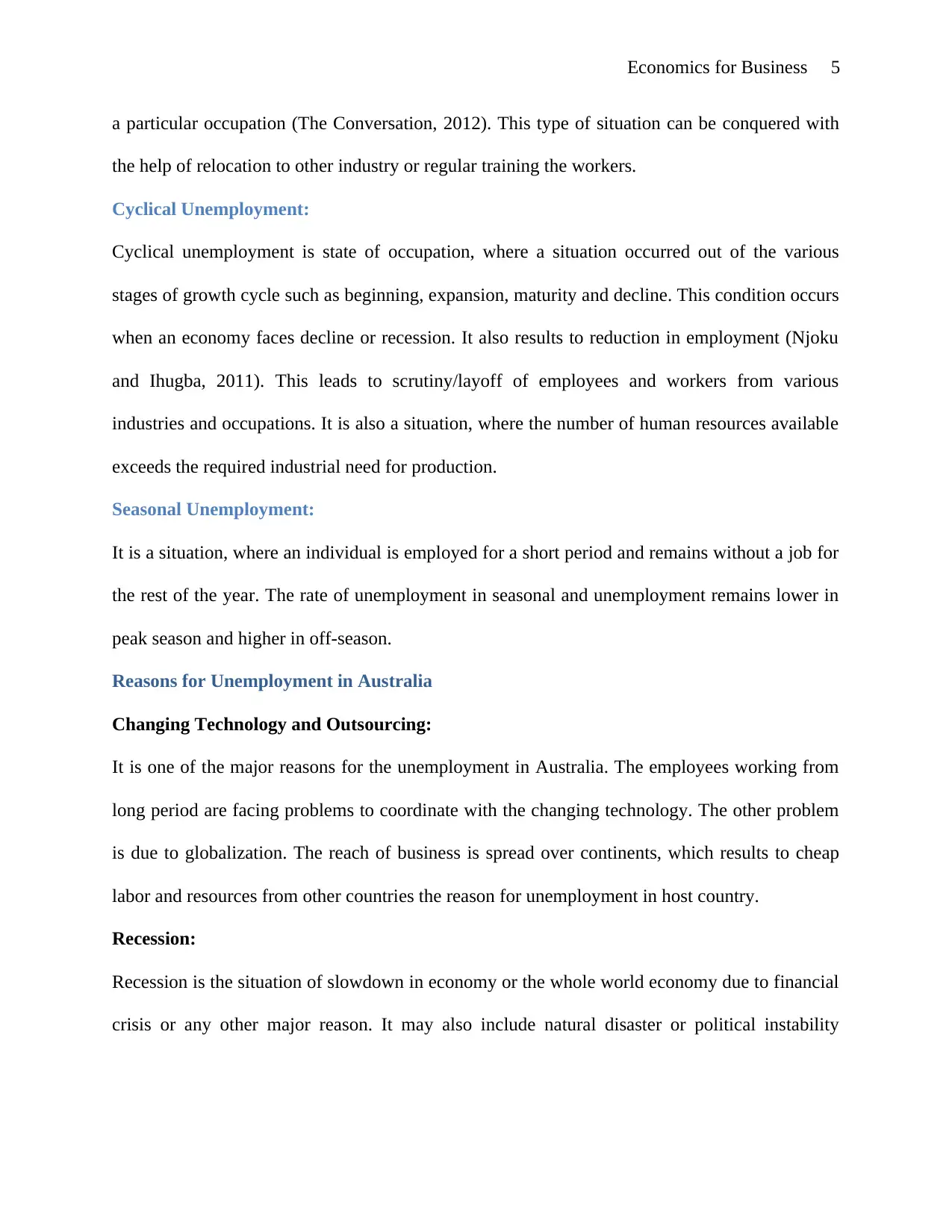
Economics for Business 5
a particular occupation (The Conversation, 2012). This type of situation can be conquered with
the help of relocation to other industry or regular training the workers.
Cyclical Unemployment:
Cyclical unemployment is state of occupation, where a situation occurred out of the various
stages of growth cycle such as beginning, expansion, maturity and decline. This condition occurs
when an economy faces decline or recession. It also results to reduction in employment (Njoku
and Ihugba, 2011). This leads to scrutiny/layoff of employees and workers from various
industries and occupations. It is also a situation, where the number of human resources available
exceeds the required industrial need for production.
Seasonal Unemployment:
It is a situation, where an individual is employed for a short period and remains without a job for
the rest of the year. The rate of unemployment in seasonal and unemployment remains lower in
peak season and higher in off-season.
Reasons for Unemployment in Australia
Changing Technology and Outsourcing:
It is one of the major reasons for the unemployment in Australia. The employees working from
long period are facing problems to coordinate with the changing technology. The other problem
is due to globalization. The reach of business is spread over continents, which results to cheap
labor and resources from other countries the reason for unemployment in host country.
Recession:
Recession is the situation of slowdown in economy or the whole world economy due to financial
crisis or any other major reason. It may also include natural disaster or political instability
a particular occupation (The Conversation, 2012). This type of situation can be conquered with
the help of relocation to other industry or regular training the workers.
Cyclical Unemployment:
Cyclical unemployment is state of occupation, where a situation occurred out of the various
stages of growth cycle such as beginning, expansion, maturity and decline. This condition occurs
when an economy faces decline or recession. It also results to reduction in employment (Njoku
and Ihugba, 2011). This leads to scrutiny/layoff of employees and workers from various
industries and occupations. It is also a situation, where the number of human resources available
exceeds the required industrial need for production.
Seasonal Unemployment:
It is a situation, where an individual is employed for a short period and remains without a job for
the rest of the year. The rate of unemployment in seasonal and unemployment remains lower in
peak season and higher in off-season.
Reasons for Unemployment in Australia
Changing Technology and Outsourcing:
It is one of the major reasons for the unemployment in Australia. The employees working from
long period are facing problems to coordinate with the changing technology. The other problem
is due to globalization. The reach of business is spread over continents, which results to cheap
labor and resources from other countries the reason for unemployment in host country.
Recession:
Recession is the situation of slowdown in economy or the whole world economy due to financial
crisis or any other major reason. It may also include natural disaster or political instability
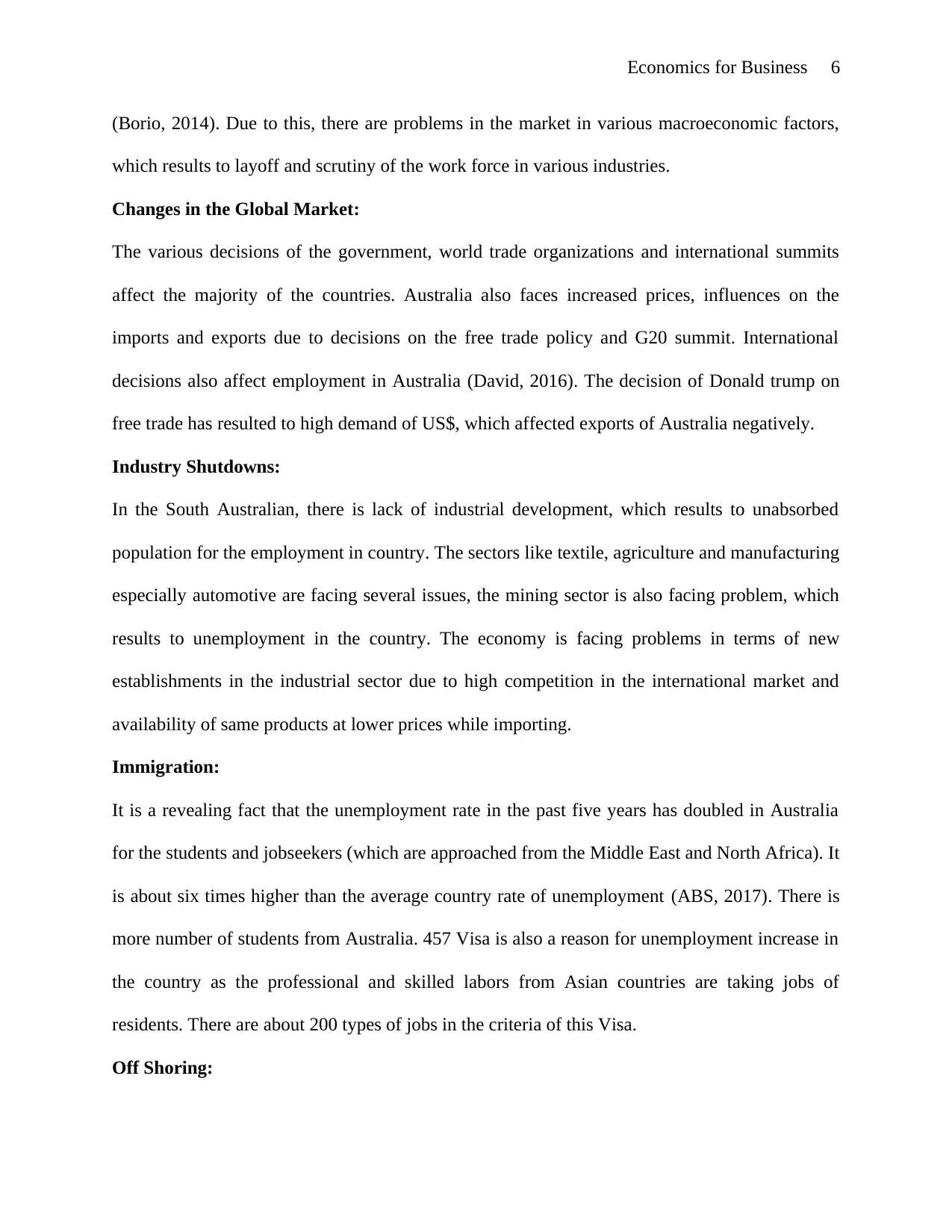
Economics for Business 6
(Borio, 2014). Due to this, there are problems in the market in various macroeconomic factors,
which results to layoff and scrutiny of the work force in various industries.
Changes in the Global Market:
The various decisions of the government, world trade organizations and international summits
affect the majority of the countries. Australia also faces increased prices, influences on the
imports and exports due to decisions on the free trade policy and G20 summit. International
decisions also affect employment in Australia (David, 2016). The decision of Donald trump on
free trade has resulted to high demand of US$, which affected exports of Australia negatively.
Industry Shutdowns:
In the South Australian, there is lack of industrial development, which results to unabsorbed
population for the employment in country. The sectors like textile, agriculture and manufacturing
especially automotive are facing several issues, the mining sector is also facing problem, which
results to unemployment in the country. The economy is facing problems in terms of new
establishments in the industrial sector due to high competition in the international market and
availability of same products at lower prices while importing.
Immigration:
It is a revealing fact that the unemployment rate in the past five years has doubled in Australia
for the students and jobseekers (which are approached from the Middle East and North Africa). It
is about six times higher than the average country rate of unemployment (ABS, 2017). There is
more number of students from Australia. 457 Visa is also a reason for unemployment increase in
the country as the professional and skilled labors from Asian countries are taking jobs of
residents. There are about 200 types of jobs in the criteria of this Visa.
Off Shoring:
(Borio, 2014). Due to this, there are problems in the market in various macroeconomic factors,
which results to layoff and scrutiny of the work force in various industries.
Changes in the Global Market:
The various decisions of the government, world trade organizations and international summits
affect the majority of the countries. Australia also faces increased prices, influences on the
imports and exports due to decisions on the free trade policy and G20 summit. International
decisions also affect employment in Australia (David, 2016). The decision of Donald trump on
free trade has resulted to high demand of US$, which affected exports of Australia negatively.
Industry Shutdowns:
In the South Australian, there is lack of industrial development, which results to unabsorbed
population for the employment in country. The sectors like textile, agriculture and manufacturing
especially automotive are facing several issues, the mining sector is also facing problem, which
results to unemployment in the country. The economy is facing problems in terms of new
establishments in the industrial sector due to high competition in the international market and
availability of same products at lower prices while importing.
Immigration:
It is a revealing fact that the unemployment rate in the past five years has doubled in Australia
for the students and jobseekers (which are approached from the Middle East and North Africa). It
is about six times higher than the average country rate of unemployment (ABS, 2017). There is
more number of students from Australia. 457 Visa is also a reason for unemployment increase in
the country as the professional and skilled labors from Asian countries are taking jobs of
residents. There are about 200 types of jobs in the criteria of this Visa.
Off Shoring:
⊘ This is a preview!⊘
Do you want full access?
Subscribe today to unlock all pages.

Trusted by 1+ million students worldwide
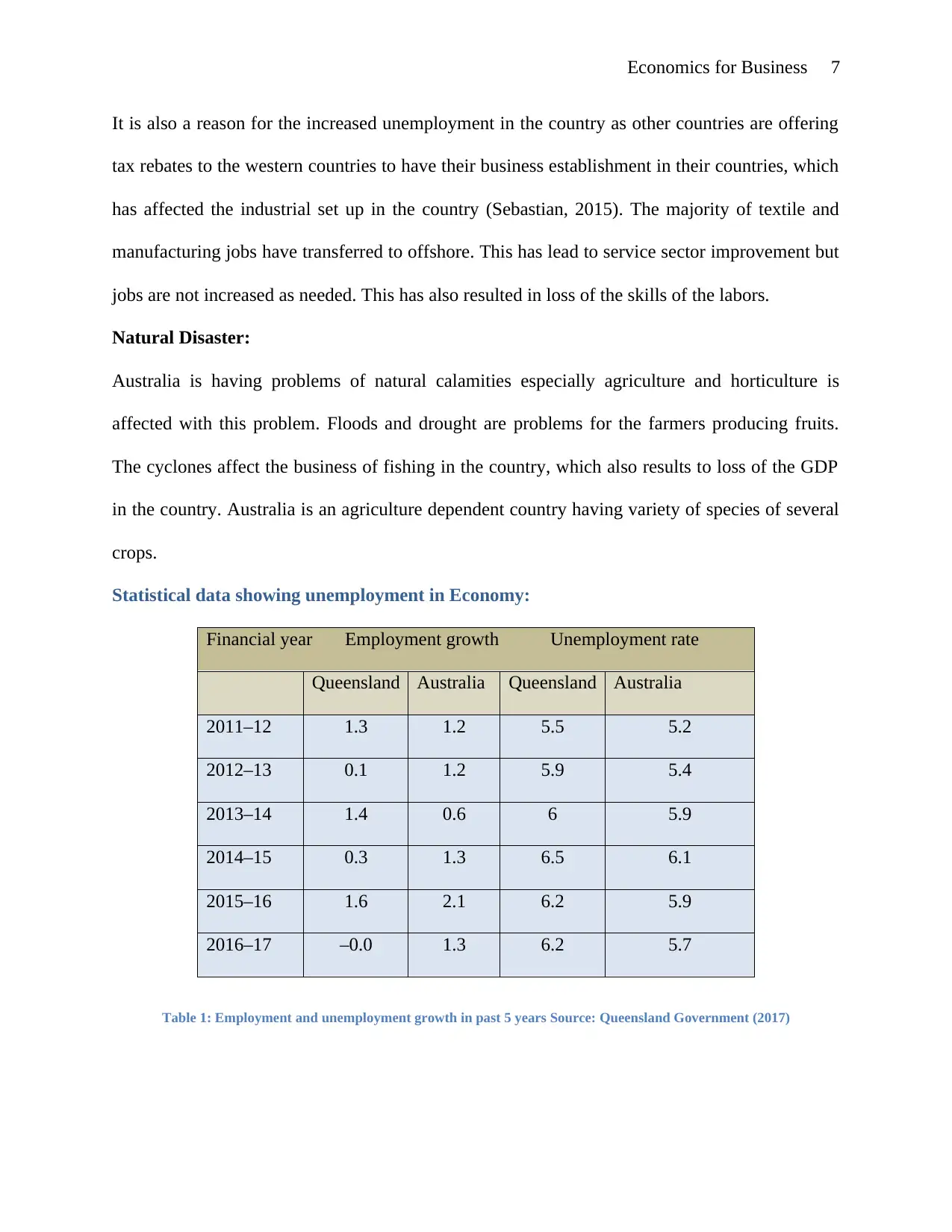
Economics for Business 7
It is also a reason for the increased unemployment in the country as other countries are offering
tax rebates to the western countries to have their business establishment in their countries, which
has affected the industrial set up in the country (Sebastian, 2015). The majority of textile and
manufacturing jobs have transferred to offshore. This has lead to service sector improvement but
jobs are not increased as needed. This has also resulted in loss of the skills of the labors.
Natural Disaster:
Australia is having problems of natural calamities especially agriculture and horticulture is
affected with this problem. Floods and drought are problems for the farmers producing fruits.
The cyclones affect the business of fishing in the country, which also results to loss of the GDP
in the country. Australia is an agriculture dependent country having variety of species of several
crops.
Statistical data showing unemployment in Economy:
Financial year Employment growth Unemployment rate
Queensland Australia Queensland Australia
2011–12 1.3 1.2 5.5 5.2
2012–13 0.1 1.2 5.9 5.4
2013–14 1.4 0.6 6 5.9
2014–15 0.3 1.3 6.5 6.1
2015–16 1.6 2.1 6.2 5.9
2016–17 –0.0 1.3 6.2 5.7
Table 1: Employment and unemployment growth in past 5 years Source: Queensland Government (2017)
It is also a reason for the increased unemployment in the country as other countries are offering
tax rebates to the western countries to have their business establishment in their countries, which
has affected the industrial set up in the country (Sebastian, 2015). The majority of textile and
manufacturing jobs have transferred to offshore. This has lead to service sector improvement but
jobs are not increased as needed. This has also resulted in loss of the skills of the labors.
Natural Disaster:
Australia is having problems of natural calamities especially agriculture and horticulture is
affected with this problem. Floods and drought are problems for the farmers producing fruits.
The cyclones affect the business of fishing in the country, which also results to loss of the GDP
in the country. Australia is an agriculture dependent country having variety of species of several
crops.
Statistical data showing unemployment in Economy:
Financial year Employment growth Unemployment rate
Queensland Australia Queensland Australia
2011–12 1.3 1.2 5.5 5.2
2012–13 0.1 1.2 5.9 5.4
2013–14 1.4 0.6 6 5.9
2014–15 0.3 1.3 6.5 6.1
2015–16 1.6 2.1 6.2 5.9
2016–17 –0.0 1.3 6.2 5.7
Table 1: Employment and unemployment growth in past 5 years Source: Queensland Government (2017)
Paraphrase This Document
Need a fresh take? Get an instant paraphrase of this document with our AI Paraphraser
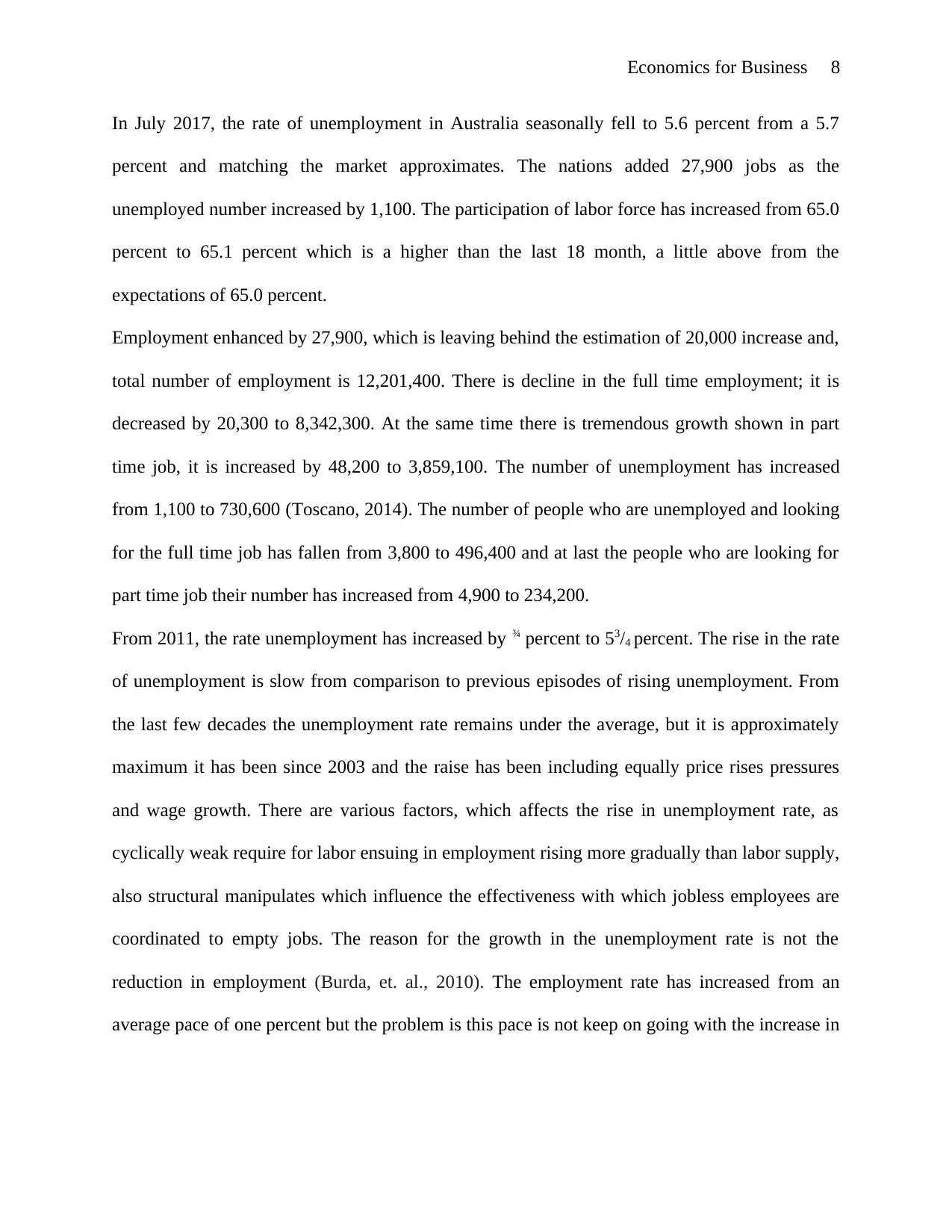
Economics for Business 8
In July 2017, the rate of unemployment in Australia seasonally fell to 5.6 percent from a 5.7
percent and matching the market approximates. The nations added 27,900 jobs as the
unemployed number increased by 1,100. The participation of labor force has increased from 65.0
percent to 65.1 percent which is a higher than the last 18 month, a little above from the
expectations of 65.0 percent.
Employment enhanced by 27,900, which is leaving behind the estimation of 20,000 increase and,
total number of employment is 12,201,400. There is decline in the full time employment; it is
decreased by 20,300 to 8,342,300. At the same time there is tremendous growth shown in part
time job, it is increased by 48,200 to 3,859,100. The number of unemployment has increased
from 1,100 to 730,600 (Toscano, 2014). The number of people who are unemployed and looking
for the full time job has fallen from 3,800 to 496,400 and at last the people who are looking for
part time job their number has increased from 4,900 to 234,200.
From 2011, the rate unemployment has increased by ¾ percent to 53/4 percent. The rise in the rate
of unemployment is slow from comparison to previous episodes of rising unemployment. From
the last few decades the unemployment rate remains under the average, but it is approximately
maximum it has been since 2003 and the raise has been including equally price rises pressures
and wage growth. There are various factors, which affects the rise in unemployment rate, as
cyclically weak require for labor ensuing in employment rising more gradually than labor supply,
also structural manipulates which influence the effectiveness with which jobless employees are
coordinated to empty jobs. The reason for the growth in the unemployment rate is not the
reduction in employment (Burda, et. al., 2010). The employment rate has increased from an
average pace of one percent but the problem is this pace is not keep on going with the increase in
In July 2017, the rate of unemployment in Australia seasonally fell to 5.6 percent from a 5.7
percent and matching the market approximates. The nations added 27,900 jobs as the
unemployed number increased by 1,100. The participation of labor force has increased from 65.0
percent to 65.1 percent which is a higher than the last 18 month, a little above from the
expectations of 65.0 percent.
Employment enhanced by 27,900, which is leaving behind the estimation of 20,000 increase and,
total number of employment is 12,201,400. There is decline in the full time employment; it is
decreased by 20,300 to 8,342,300. At the same time there is tremendous growth shown in part
time job, it is increased by 48,200 to 3,859,100. The number of unemployment has increased
from 1,100 to 730,600 (Toscano, 2014). The number of people who are unemployed and looking
for the full time job has fallen from 3,800 to 496,400 and at last the people who are looking for
part time job their number has increased from 4,900 to 234,200.
From 2011, the rate unemployment has increased by ¾ percent to 53/4 percent. The rise in the rate
of unemployment is slow from comparison to previous episodes of rising unemployment. From
the last few decades the unemployment rate remains under the average, but it is approximately
maximum it has been since 2003 and the raise has been including equally price rises pressures
and wage growth. There are various factors, which affects the rise in unemployment rate, as
cyclically weak require for labor ensuing in employment rising more gradually than labor supply,
also structural manipulates which influence the effectiveness with which jobless employees are
coordinated to empty jobs. The reason for the growth in the unemployment rate is not the
reduction in employment (Burda, et. al., 2010). The employment rate has increased from an
average pace of one percent but the problem is this pace is not keep on going with the increase in
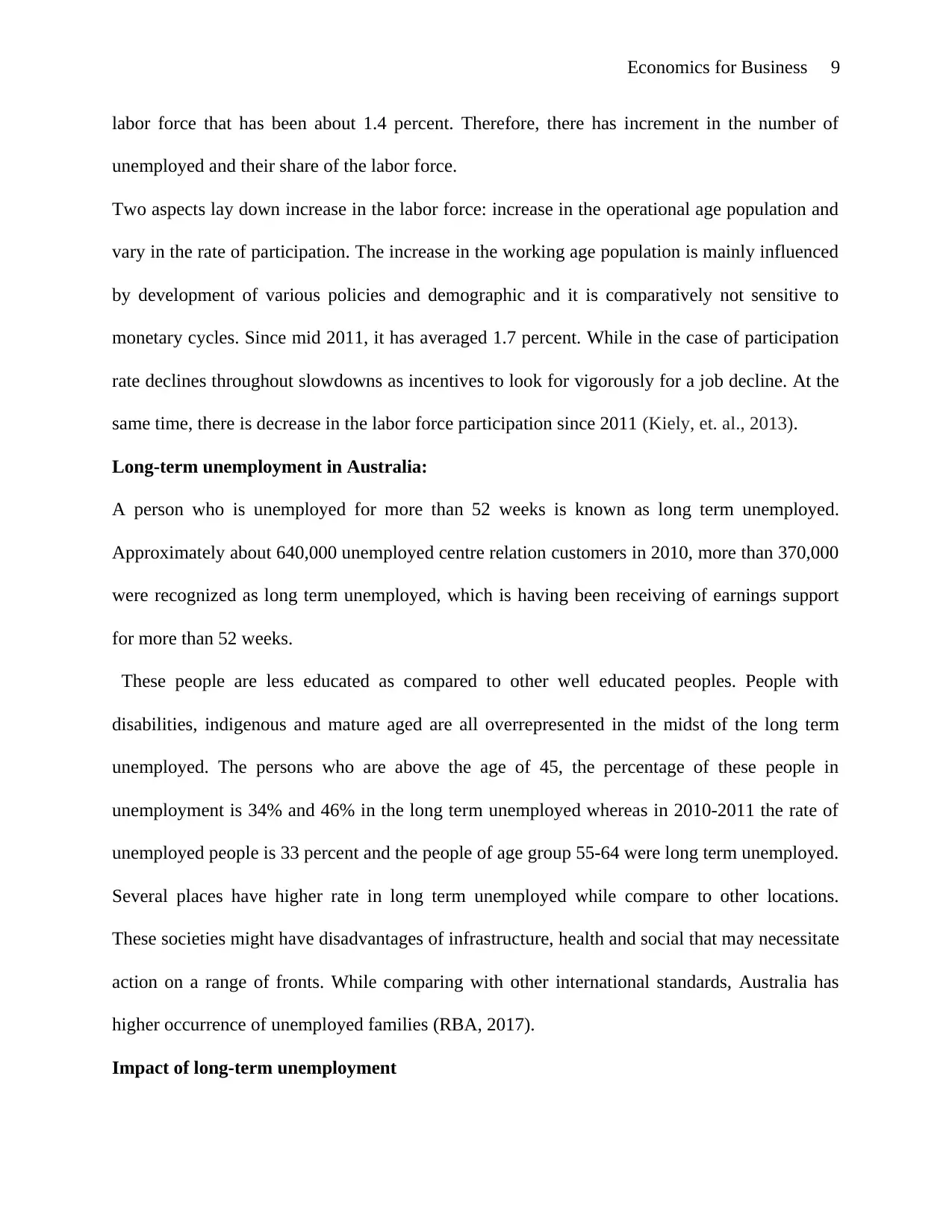
Economics for Business 9
labor force that has been about 1.4 percent. Therefore, there has increment in the number of
unemployed and their share of the labor force.
Two aspects lay down increase in the labor force: increase in the operational age population and
vary in the rate of participation. The increase in the working age population is mainly influenced
by development of various policies and demographic and it is comparatively not sensitive to
monetary cycles. Since mid 2011, it has averaged 1.7 percent. While in the case of participation
rate declines throughout slowdowns as incentives to look for vigorously for a job decline. At the
same time, there is decrease in the labor force participation since 2011 (Kiely, et. al., 2013).
Long-term unemployment in Australia:
A person who is unemployed for more than 52 weeks is known as long term unemployed.
Approximately about 640,000 unemployed centre relation customers in 2010, more than 370,000
were recognized as long term unemployed, which is having been receiving of earnings support
for more than 52 weeks.
These people are less educated as compared to other well educated peoples. People with
disabilities, indigenous and mature aged are all overrepresented in the midst of the long term
unemployed. The persons who are above the age of 45, the percentage of these people in
unemployment is 34% and 46% in the long term unemployed whereas in 2010-2011 the rate of
unemployed people is 33 percent and the people of age group 55-64 were long term unemployed.
Several places have higher rate in long term unemployed while compare to other locations.
These societies might have disadvantages of infrastructure, health and social that may necessitate
action on a range of fronts. While comparing with other international standards, Australia has
higher occurrence of unemployed families (RBA, 2017).
Impact of long-term unemployment
labor force that has been about 1.4 percent. Therefore, there has increment in the number of
unemployed and their share of the labor force.
Two aspects lay down increase in the labor force: increase in the operational age population and
vary in the rate of participation. The increase in the working age population is mainly influenced
by development of various policies and demographic and it is comparatively not sensitive to
monetary cycles. Since mid 2011, it has averaged 1.7 percent. While in the case of participation
rate declines throughout slowdowns as incentives to look for vigorously for a job decline. At the
same time, there is decrease in the labor force participation since 2011 (Kiely, et. al., 2013).
Long-term unemployment in Australia:
A person who is unemployed for more than 52 weeks is known as long term unemployed.
Approximately about 640,000 unemployed centre relation customers in 2010, more than 370,000
were recognized as long term unemployed, which is having been receiving of earnings support
for more than 52 weeks.
These people are less educated as compared to other well educated peoples. People with
disabilities, indigenous and mature aged are all overrepresented in the midst of the long term
unemployed. The persons who are above the age of 45, the percentage of these people in
unemployment is 34% and 46% in the long term unemployed whereas in 2010-2011 the rate of
unemployed people is 33 percent and the people of age group 55-64 were long term unemployed.
Several places have higher rate in long term unemployed while compare to other locations.
These societies might have disadvantages of infrastructure, health and social that may necessitate
action on a range of fronts. While comparing with other international standards, Australia has
higher occurrence of unemployed families (RBA, 2017).
Impact of long-term unemployment
⊘ This is a preview!⊘
Do you want full access?
Subscribe today to unlock all pages.

Trusted by 1+ million students worldwide
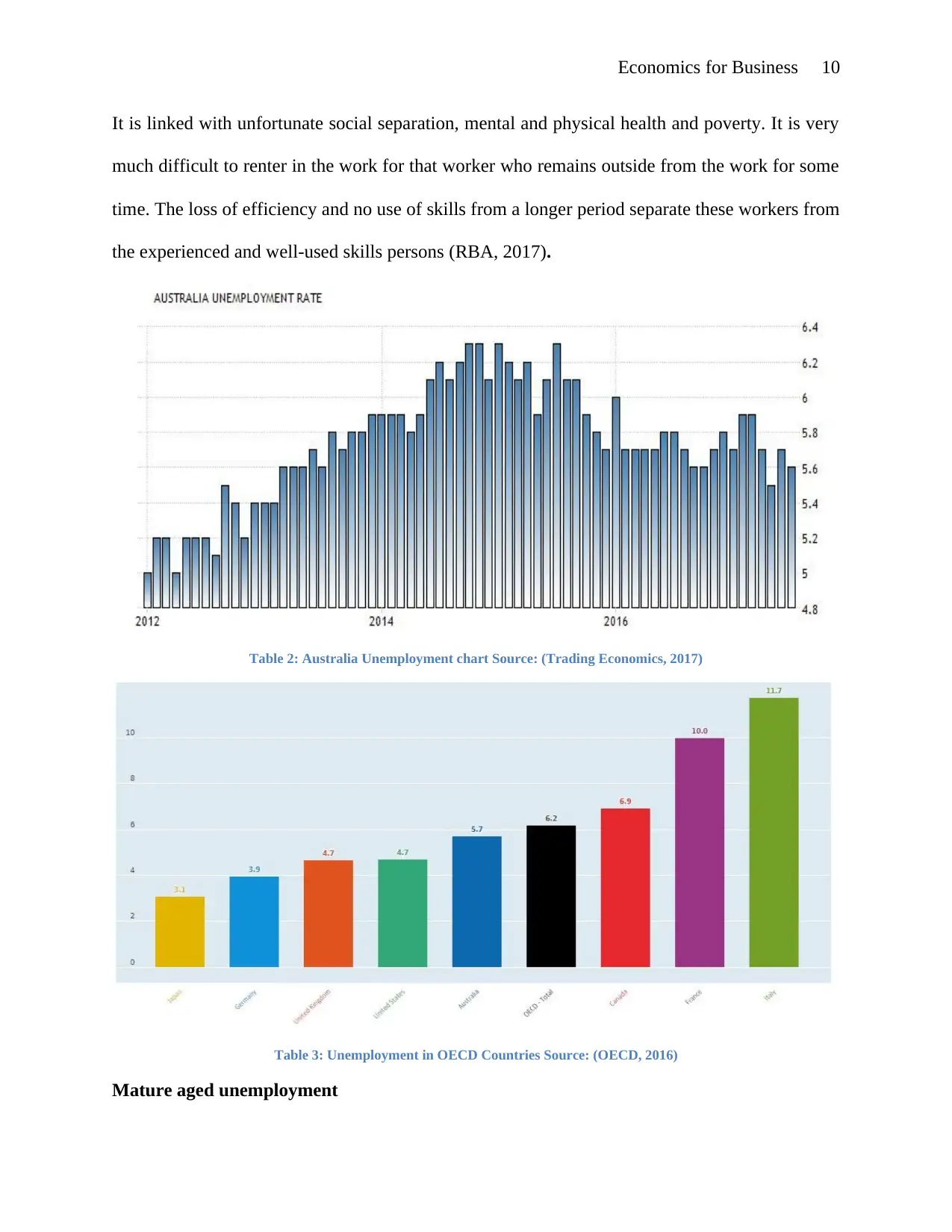
Economics for Business 10
It is linked with unfortunate social separation, mental and physical health and poverty. It is very
much difficult to renter in the work for that worker who remains outside from the work for some
time. The loss of efficiency and no use of skills from a longer period separate these workers from
the experienced and well-used skills persons (RBA, 2017).
Table 2: Australia Unemployment chart Source: (Trading Economics, 2017)
Table 3: Unemployment in OECD Countries Source: (OECD, 2016)
Mature aged unemployment
It is linked with unfortunate social separation, mental and physical health and poverty. It is very
much difficult to renter in the work for that worker who remains outside from the work for some
time. The loss of efficiency and no use of skills from a longer period separate these workers from
the experienced and well-used skills persons (RBA, 2017).
Table 2: Australia Unemployment chart Source: (Trading Economics, 2017)
Table 3: Unemployment in OECD Countries Source: (OECD, 2016)
Mature aged unemployment
Paraphrase This Document
Need a fresh take? Get an instant paraphrase of this document with our AI Paraphraser
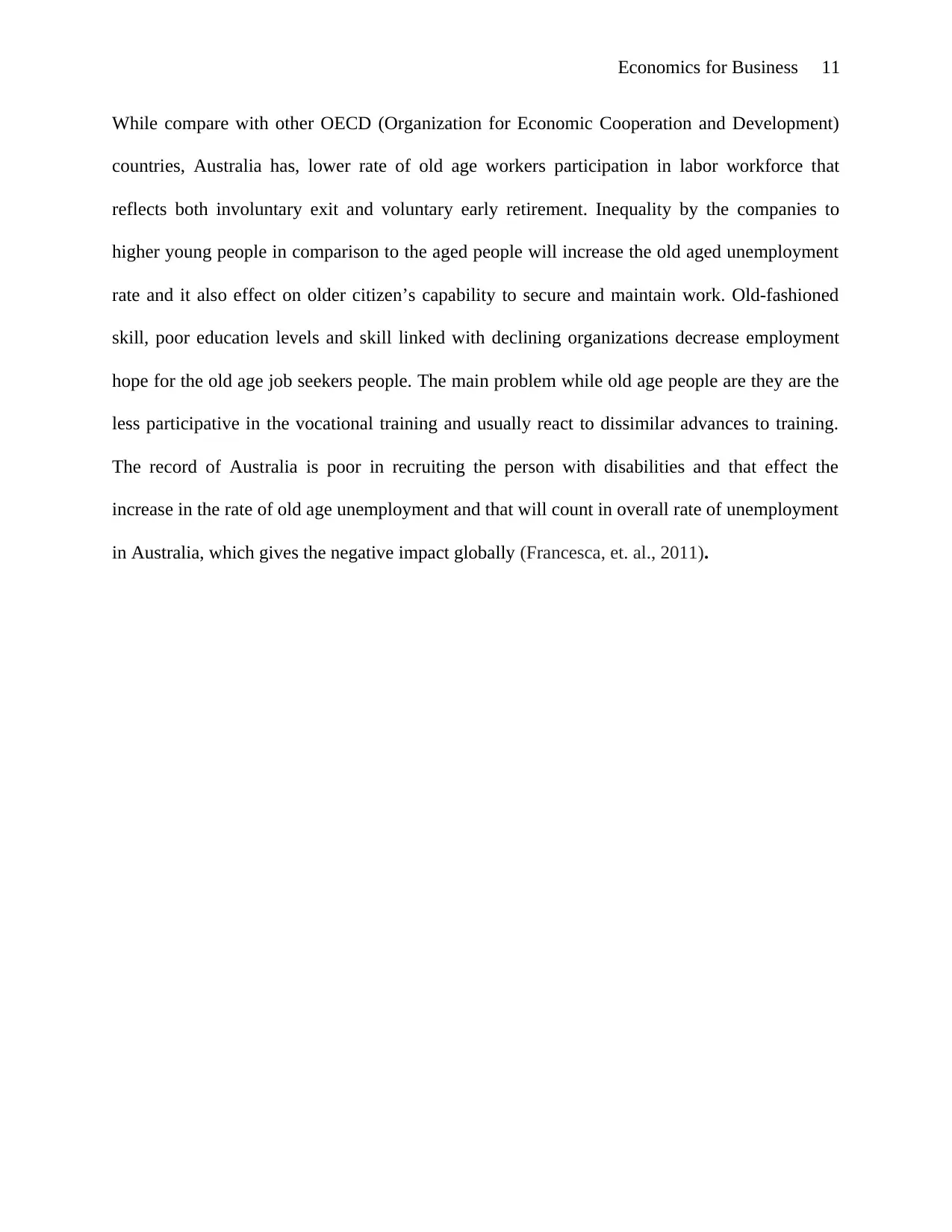
Economics for Business 11
While compare with other OECD (Organization for Economic Cooperation and Development)
countries, Australia has, lower rate of old age workers participation in labor workforce that
reflects both involuntary exit and voluntary early retirement. Inequality by the companies to
higher young people in comparison to the aged people will increase the old aged unemployment
rate and it also effect on older citizen’s capability to secure and maintain work. Old-fashioned
skill, poor education levels and skill linked with declining organizations decrease employment
hope for the old age job seekers people. The main problem while old age people are they are the
less participative in the vocational training and usually react to dissimilar advances to training.
The record of Australia is poor in recruiting the person with disabilities and that effect the
increase in the rate of old age unemployment and that will count in overall rate of unemployment
in Australia, which gives the negative impact globally (Francesca, et. al., 2011).
While compare with other OECD (Organization for Economic Cooperation and Development)
countries, Australia has, lower rate of old age workers participation in labor workforce that
reflects both involuntary exit and voluntary early retirement. Inequality by the companies to
higher young people in comparison to the aged people will increase the old aged unemployment
rate and it also effect on older citizen’s capability to secure and maintain work. Old-fashioned
skill, poor education levels and skill linked with declining organizations decrease employment
hope for the old age job seekers people. The main problem while old age people are they are the
less participative in the vocational training and usually react to dissimilar advances to training.
The record of Australia is poor in recruiting the person with disabilities and that effect the
increase in the rate of old age unemployment and that will count in overall rate of unemployment
in Australia, which gives the negative impact globally (Francesca, et. al., 2011).
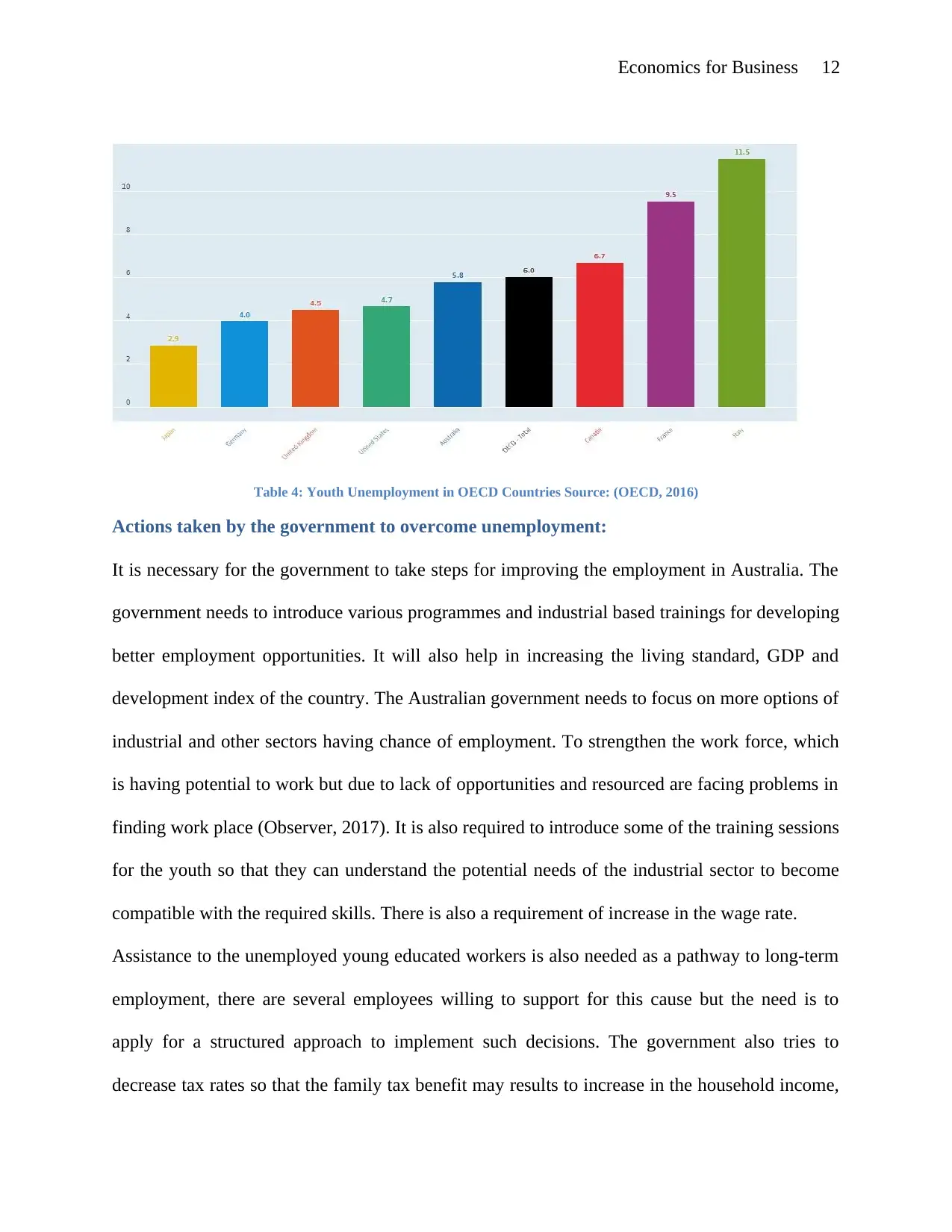
Economics for Business 12
Table 4: Youth Unemployment in OECD Countries Source: (OECD, 2016)
Actions taken by the government to overcome unemployment:
It is necessary for the government to take steps for improving the employment in Australia. The
government needs to introduce various programmes and industrial based trainings for developing
better employment opportunities. It will also help in increasing the living standard, GDP and
development index of the country. The Australian government needs to focus on more options of
industrial and other sectors having chance of employment. To strengthen the work force, which
is having potential to work but due to lack of opportunities and resourced are facing problems in
finding work place (Observer, 2017). It is also required to introduce some of the training sessions
for the youth so that they can understand the potential needs of the industrial sector to become
compatible with the required skills. There is also a requirement of increase in the wage rate.
Assistance to the unemployed young educated workers is also needed as a pathway to long-term
employment, there are several employees willing to support for this cause but the need is to
apply for a structured approach to implement such decisions. The government also tries to
decrease tax rates so that the family tax benefit may results to increase in the household income,
Table 4: Youth Unemployment in OECD Countries Source: (OECD, 2016)
Actions taken by the government to overcome unemployment:
It is necessary for the government to take steps for improving the employment in Australia. The
government needs to introduce various programmes and industrial based trainings for developing
better employment opportunities. It will also help in increasing the living standard, GDP and
development index of the country. The Australian government needs to focus on more options of
industrial and other sectors having chance of employment. To strengthen the work force, which
is having potential to work but due to lack of opportunities and resourced are facing problems in
finding work place (Observer, 2017). It is also required to introduce some of the training sessions
for the youth so that they can understand the potential needs of the industrial sector to become
compatible with the required skills. There is also a requirement of increase in the wage rate.
Assistance to the unemployed young educated workers is also needed as a pathway to long-term
employment, there are several employees willing to support for this cause but the need is to
apply for a structured approach to implement such decisions. The government also tries to
decrease tax rates so that the family tax benefit may results to increase in the household income,
⊘ This is a preview!⊘
Do you want full access?
Subscribe today to unlock all pages.

Trusted by 1+ million students worldwide
1 out of 17
Related Documents
Your All-in-One AI-Powered Toolkit for Academic Success.
+13062052269
info@desklib.com
Available 24*7 on WhatsApp / Email
![[object Object]](/_next/static/media/star-bottom.7253800d.svg)
Unlock your academic potential
Copyright © 2020–2025 A2Z Services. All Rights Reserved. Developed and managed by ZUCOL.




